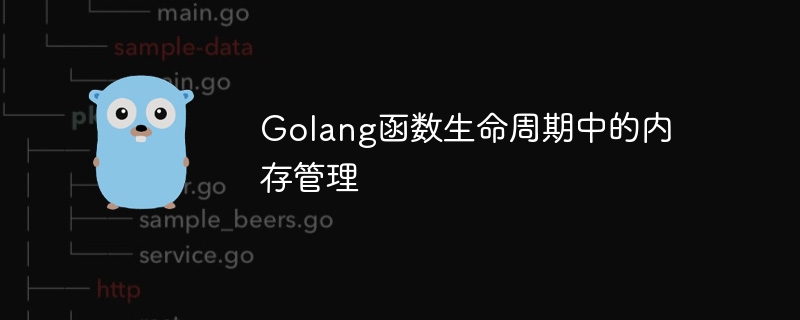
During the Go function life cycle, memory management proceeds as follows: a stack frame is created when the function is called, which is used to store local variables and other information. When the function returns, the stack frame is destroyed and the memory is released. When more than 32KB of data is allocated, memory is allocated on the heap and managed by the garbage collector. After the function ends, the unused memory on the heap will be reclaimed by the garbage collector.

Memory management in the function life cycle in Go
In the Go language, there is a specific pattern in the function life cycle , during this process, variables are created and destroyed on the stack and heap. Understanding how memory management interacts with function lifecycle is crucial to writing efficient Go code.
Function call stack
When a function is called, it adds itself to the call stack. The amount of memory it occupies is called a stack frame, which contains local variables, function parameters, and pointers to function return values.
When a function returns, its stack frame is popped and the memory it occupies is released. This ensures that local variables do not survive beyond the scope of the function.
Heap
The heap is an area of dynamic memory allocation in the Go language. When a function allocates more than 32KB of data, it allocates on the heap. Memory allocation on the heap is managed by the garbage collector.
Example
Let us demonstrate memory management during function lifecycle in Go through an example:
package main
import (
"fmt"
"runtime"
)
func main() {
// 分配一个大内存块(> 32KB)
arr := make([]int, 100000)
// 输出堆分配的大小
fmt.Println("Heap memory allocated before function call:", runtime.MemStats().HeapAlloc)
// 调用包含大内存块的函数
bigArrayFunction(arr)
// 输出堆分配的大小
fmt.Println("Heap memory allocated after function call:", runtime.MemStats().HeapAlloc)
}
func bigArrayFunction(arr []int) {
// 在函数内部使用大内存块
_ = arr[len(arr)-1]
}When running this code, the output is as follows :
Heap memory allocated before function call: 0 Heap memory allocated after function call: 4106656
The large memory block allocated inside the function bigArrayFunction will be reclaimed by the garbage collector when the function returns, thus resetting the heap allocated size to 0.
Best Practices
To ensure efficient function life cycle memory management, you can use the following best practices:
The above is the detailed content of Memory management in Golang function life cycle. For more information, please follow other related articles on the PHP Chinese website!
 How to define variables in golang
How to define variables in golang
 What are the data conversion methods in golang?
What are the data conversion methods in golang?
 What are the commonly used libraries in golang?
What are the commonly used libraries in golang?
 What is the difference between golang and python
What is the difference between golang and python
 wifi password
wifi password
 What does Metaverse Concept Stock mean?
What does Metaverse Concept Stock mean?
 Why is the mobile hard drive so slow to open?
Why is the mobile hard drive so slow to open?
 How to enter BIOS on thinkpad
How to enter BIOS on thinkpad




